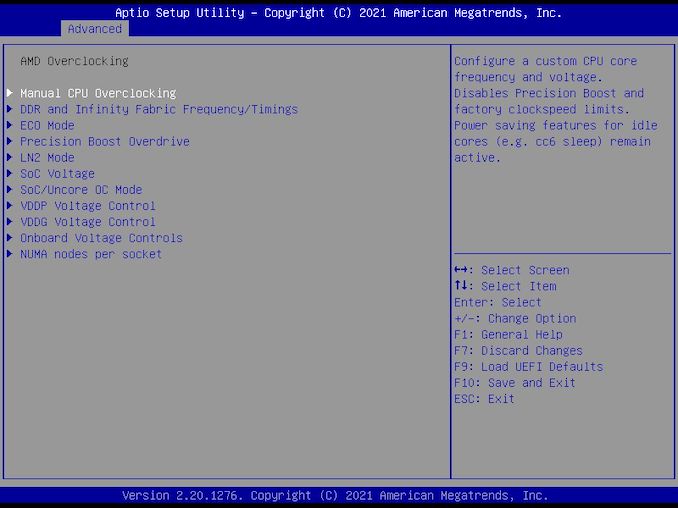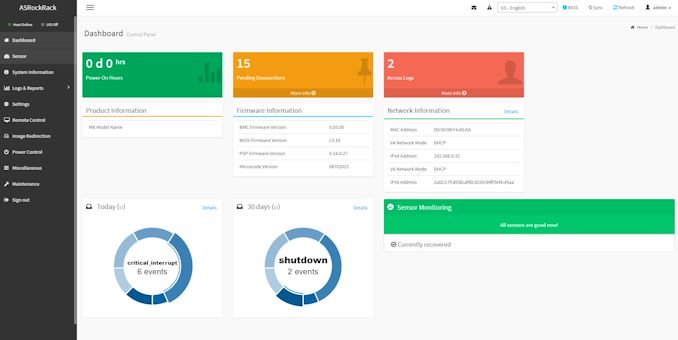ASRock Rack B550D4-4L Motherboard Review: B550 Goes Professional with BMC
by Gavin Bonshor on May 20, 2021 9:00 AM ESTBIOS
ASRock Rack is using an American Megatrends Aptio based firmware for the B550D4-4L. The design of the firmware is basic, with a royal blue framing, and grey background. It's an archaic aesthetic, but it is geared more towards commercial users than providing flashy GUI's from that of consumer desktop models.
Pressing the Del key allows users to enter the BIOS, and the first screen users will see is the Main section. This section displays information about the installed processor, cache sizes and specification, as well as system memory installed and the relevant speeds. At the right-hand side, there's a hotkey list that includes basic information on what each hotkey does, eg, F1 for the help menu, F7 to discard any changes made in the firmware, F9 to load the board's UEFI default settings, and F10 to save and exit the BIOS.
Despite its professional-level functionality with support for both non-ECC and ECC memory which is consistent with server and workstation usage, as the B550D4-4L is based on the AMD B550 chipset, it does officially support overclocking. The board's overclocking settings primarily come from the platform, with very antiquated levels of settings available for users. Generally speaking, while the B550D4-4L supports overclocking, both manually and with AMD's Precision Boost Overdrive, it's not recommended to push the processors too much for a couple of reasons. The first is the 4+2 power delivery isn't considered very premium, and they are typically built to specification for these types of boards without any overcompensation of componentry. The second is the power delivery heatsinks aren't capable of holding a consistent level of heat, due to their size, overall mass, and positioning on the board. Users are more than welcome to overclock on this model to their heart's content, but we simply wouldn't recommend it for the reasons stated above.
A lot of the firmware functionality revolves around professional elements, such as security, power management, and BMC control. Configuration of the BMC can be done within the Server Management section and allows users to create custom IP addresses so the system can be accessed over a network. Overall the firmware on the ASRock Rack B550D4-4L is functional but without the glitz and glamour of desktop models. It is responsive to USB keyboards and mice and provides everything users need to get server-focused systems up and running.
Software
The ASRock Rack B5504D-4L doesn't come supplied with any software as such, but it does include an ASPEED AST2500 BMC controller, which can be accessed remotely via a single Realtek RTL8221E Gigabit Ethernet port on the rear panel. Setting up the BMC IP address within the firmware is easy enough for an experienced user, but for amateur users, there are plenty of guides available online.
The ASRock Rack IPMI can be accessed by inputting the IP address and settings set within the BMC section of the firmware. The usual method of logging into the IPMI is with a predefined set of credentials, in this case with the username and password, admin/admin.
New legislation via Senate Bill No. 327, under California Law which was passed in 2018, states that each device comes supplied with unique credentials for each individual device. Technically, ASRock Rack is in breach of this law which means that the B550D4-4L wouldn't be permitted to be sold within California.
Upon logging in for the first time, the IPMI does request that users create a new password that could be considered a circumvention of the law, but we aren't legal experts by any stretch and as such, don't want to speculate on this.
The ASRock Rack IPMI is very functional, informative, and uses a clean-cut GUI. One of the highlights of the GUI is in the dashboard, which provides critical information on power uptime, critical interrupt errors, and any shutdown errors encountered on the system. It also provides information on overall sensor health through sensor monitoring. Any errors or anomalies, or any sensors operating with temperatures or voltages outside of common parameters, will be displayed on the dashboard. The ASRock Rack IPMI also provides many different functions, including a comprehensive sensor monitoring page, a KVM viewer with HTML5 and Java variants for users to utilize, as well as control of power settings, such as powering up or down the system remotely. This also stretched to typical maintenance elements such as updating the firmware of the board remotely and backing up system data.
Overall ASRock Rack's IPMI interface is one of the better ones we've used in recent years and provides more than enough functionality when combines with the ASPEED AST2500 BMC controller and Realtek RTL8211E Gigabit Ethernet remote access point.


























73 Comments
View All Comments
mode_13h - Monday, May 24, 2021 - link
I can understand the sentiment of wanting 10G to take hold, so that prices will come down.Some of ASRock Rack's boards do have an option that includes a 10 Gigabit controller. I've had my eye on the X570D4U-2L2T, in fact.
I think the reason this probably lacks 10 Gigabit is that they have two X570-based boards with 10 Gigabit (and one without). The point of the B550 board is to be lower-priced. So, if someone wants it, they can easily just step up to one of the X570s that has it.
spikebike - Tuesday, December 28, 2021 - link
The article mentions a variant of the B550d4 with 2x10G.fmyhr - Thursday, May 20, 2021 - link
Would many of this board's prospective users really use a GTX 980 and 1200W 75% PSU? Personally if I'm willing to spend that much electricity on a server, I'd go EPYC. The benefit of this board AFAICT is the ability to construct a true Ryzen server (i.e. ECC RAM and OoB management) that uses less power, and may cost less, than EPYC. Tradeoff is far less I/O bandwidth, and lower limit on CPU cores. Anyway, back to point: to lower power use with this you'd want to match power supply to actual requirement, something ~400W, preferably 90+ Gold or better efficiency, is probably a lot more appropriate.Einy0 - Thursday, May 20, 2021 - link
Agreed, I'd much rather see power consumption numbers using just the BMC for video and an appropriately sized power supply.dsplover - Thursday, May 20, 2021 - link
Excellent niche board, perfect for Pro Audio Workstation, as well as a 1U build.Just need the 5700G to get me to jump.
Nice Review
hansmuff - Thursday, May 20, 2021 - link
"The only negative in performance came in our DPC latency testing, with our results showing that this board isn't suitable for DAW systems."dsplover - Thursday, May 20, 2021 - link
DPC Latency is of no concern as I run an external DSP Audio/MIDI Interface.Been using ASRock Rack boards for years, even though they “bench” poorly.
It’s the stability that counts for me. They are pricey but then so am I....
hansmuff - Tuesday, May 25, 2021 - link
Fair enough!edogawaconan - Thursday, May 20, 2021 - link
From the manufacturer's page:"For AMD Ryzen Desktop Processors with Radeon Graphics, ECC support is only with Processors with PRO technologies"
Pretty sure this means only G series of Ryzen don't have ECC support.
fmyhr - Thursday, May 20, 2021 - link
As best I've been able to determine, Ryzen APUs do not support ECC unless they're of the "Pro" variety. Read somewhere this is because the iGPU must also support ECC, and most of them do not. Don't know why AMD makes this info so difficult to find out, OR why they've so far shipped Pro APUs only to OEMs, none to retail. It's like they don't WANT to compete with Xeon E3. </rant>